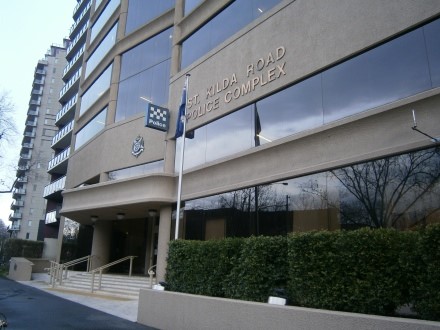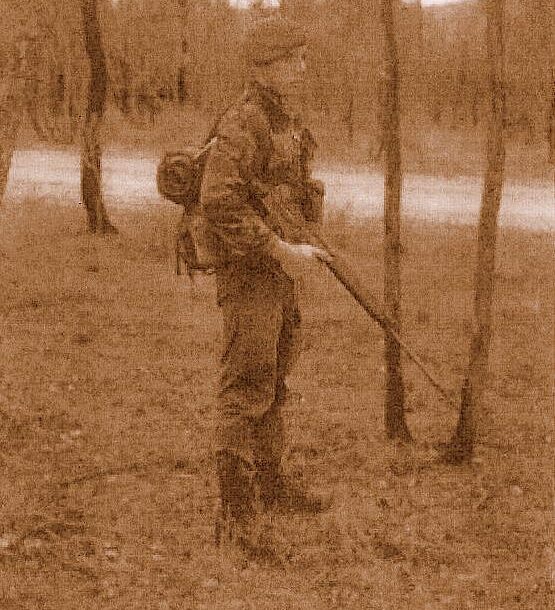Editor’s Note:
Similar to forensic psychiatrist Dr David Sime’s examination schedule for Julian Knight, during the evidence gathering process bwteen the date of the Hoddle Street Shootings and the Sentencing, Consultant Forensic Psychologist, Mr Tim Watson-Munro also examined Knight on five occasions in Pentridge Prison’s hospital and in H Division during the period 29th August 1987 – 2nd February 1988.
Similarly of consequential relevance, Mr Tim Watson-Munro was another consulting expert witnesses seconded by the Victorian Crown prosecution lawyers on a regular basis to examine arrested criminal offenders charged with serious crimes, so again effectively Mr Tim Watson-Munro was gathering evided for the prosecution teams, not defendant defence teams. Mr Tim Watson-Munro rooms were similarly situated on the same Level 2 in very same Medical Centre highrise building at 517 St Kilda Road just a kilometre south of the then St Kilda Road Police Complex located at 412 St Kilda Road.

Indeed, Mr Tim Watson-Munro was all but on the payroll with Victoria Police as a Lecturer in Psychology at the Detective Training School, and on the payroll of Victorian Office of Corrections as a go to Consultant Psychologist, and on the payroll of the Australian Federal Police as a Lecturer in Psychology.
Ahead of Dr Sime psychiatrically examining Julian Knight in person, Dr Sime had first had full access to the following prosecution evidence collected:
- The 14 hour video/audio of homicide detectives interviewing Knight at the St Kilda Road Police Complex
- The video of crime scene re-enactment video of 10th August 1987 of homicide detectives with Knight
- Written evidence of the Hoddle Street Shooting scribed by the homicide detectives and other collected evidence relevant to Knight’s case for the prosecution
Mr Tim Watson-Munro fivc face-to-face interview examinations with Knight totalled 11 hours. This involved diagnostic interviews and administered a battery of psychometric tests. These tests being the following:
- The Wechsler Adult Intelligence Scale – Revised (WAIS-R) test
- The Minnesota Multiphasic Personality Inventory (MMPI) objective test, and
- The projective Rorschach Ink Blot test.
He also interviewed Knight’s father and mother.
The following is the professional opinion of forensic psychologist Mr Tim Watson-Munro, which was contained in a written report prepared by him on the 29th February 1988. (Mr Watson-Munro’s opinion was contained on pages 17-20 of his written report).
“OPINION
This is a most complex and tragic case in which a young man with no prior convictions has caused the death of some seven people and the wounding of 19 others at Clifton Hill on the 9th August 1987. In appraising Mr Knight’s background history and, in particular, the eight or so months preceding the offences it would seem, at face value, that he has led a relatively normal life apart from some indications of behavioural disturbance whilst at school. Discussions with both his parents suggest that he was a popular child who was aware from an early age..and who had somewhat of a propensity to lead others into school pranks with minor disciplinary consequences.
However it would appear that his outlook on life dramatically deteriorated during the six months that he was based at Duntroon in the setting of his inability to relate to his superiors and peers, and an associated state of depression, frustration and, one suspects, repressed hostility, which eventually surfaced on the night of the 31 st May 1987, when his Company Sergeant Major, Mr Philip “Mongo” Reed, was stabbed. Shortly after this he was to be discharged from the Royal Military College and returned to Melbourne and in hindsight it is clearly regrettable that he was not channelled into some form of therapy at that point. Most certainly more comprehensive debriefing should have occurred at the time of his discharge.
Closer history taking suggests that there have in fact been several important issues for Mr Knight in the course of his life including his preoccupation with the military and his strong desire from childhood onwards to enter in the Australian Army at officer level. Another important factor which emerged towards the end of my discussions with him over a five month period…and although his parents and, to a lesser extent, Mr Knight tended to play this down as a factor of significance, it is quite evident that much to the contrary Knight was increasingly concerned about his origins and indeed in the past 12 months or so had made reasonably strenuous enquiries in terms of locating his natural mother. To this end his attempts were largely thwarted and when last seen on the 2 nd February 1988, a large percentage of our discussion focused upon his future plans concerning this unfulfilled aspiration.
For example, he stated that upon his eventual release from custody (should this ever occur) that he would have intentions of travelling to South Africa in anattempt to locate his mother who apparently now resides there. It is clear that the level of frustration that he experienced in this regard had some bearing upon his apparent depression and frame of mind at the time of his training at Duntroon and indeed subsequent to his discharge.
One cannot however overlook the very real and significant impact that his time at the Royal Military College at Duntroon had upon his frame of mind in the setting of the allegations of ongoing victimization and bastardization that he was experiencing, and which have been detailed in the body of my report. It is evident that as time progressed Mr Knight could see his life-long ambitions dissolving away and, associated with this, possibly his only means of attaining some form of self-respect, which at a deeper level had clearly been lacking in terms of his self-concept. Associated with this he was becoming increasingly confused with a mixture of depression and extreme anger towards a system that had apparently “done him down”.
As noted, the indications of a fairly disturbed frame of mind was becoming increasingly apparent and indeed were to initially culminate on the night of the 31 st May 1987, when in the setting of his being allegedly bullied at “The Bin” Canberra nightclub he was to stab his Company Sergeant Major. Following this he was to spend some time in a civilian hospital in Canberra [Royal Canberra Hospital] before being discharged following intensive negotiations conducted through his father and the authorities there.
One cannot emphasize sufficiently the negligence of the Armed Services here in not adequately debriefing Mr Knight at that time with a view to channelling him into treatment. It is also apparent that when he returned to Melbourne the situation had markedly changed for him in terms of his former social support networks disintegrating and in this setting he found himself in a fairly lonely and isolated situation.
It is evident that his failed relationship with Miss Renee Cross had an additional bearing upon his mood state and although his mother was evidently quite supportive, no-one was sufficiently attuned to his moods to pick up on the ongoing deterioration in his mental state that was occurring. In relation to this I refer to his descriptions of rather bizarre and destruction fantasies that he was evidently experiencing prior to the Hoddle Street incident and which involved him shooting considerable numbers of people, sometimes in the context of a delusional belief that the Clifton Hill area and, on a more general basis, Melbourne was being invaded.
In terms of the Hoddle Street incident itself, Mr Knight stated that on the evening of the killings he believed that the area was under invasion and that indeed he was “called to arms” in order to defend his territory. It is quite evident in discussions with him and indeed through viewing the relevant video material that he was quite dissociated from his behaviour and indeed in discussions regarding the incident he talks about “the body count”, “the gunship” (alluding to the police helicopter), and a sense of invasion. He also expresses some satisfaction at the time when his fire was returned [the shot fired at him in Hoddle Street] as he believed that battle had begun in earnest. The difficulty of course in assessing his comments relates to whether they are in fact sincere or, alternatively, are a post hoc reconstruction with a view towards creating an atmosphere of mitigation and hence leniency.
This clearly points to the advantage of having spent a considerable amount of time with him over a period of months and it is quite evident in terms of my discussions with him that he is to an extent continuing to deteriorate and at times is having difficulty distinguishing his fantasies from reality. Indeed in a very real sense he is at times apparently delusional in his thinking. This would be consistent with his descriptions of his frame of mind at the time of the offences.
When one assesses his formal testing results I have noted that there is a tendency towards dissociative type of behaviour, both at an objective and projective level of testing, and additionally that he is an impulsive person who has a tendency to rationalize and intellectualize as a means of defending his impulses. Certainly at a psychometric level there were no concrete indications of psychoticism although this in itself does not preclude this as a possibility in the setting of him lapsing into periodic insanity which may not be picked up through formal testing but which has been to an extent indicated in terms of discussions with him and clinical observations of him. This in turn would be consistent with the notion of temporary insanity at the time that the offences occurred.
In reviewing the literature concerning mass murderers it would appear that Mr Knight does not fit any particular profile as described except to say that like most people who commit this type of offence, he is striking by his lack of social indicators. It is evident that in considering Mr Knight’s position there is a differential diagnosis between one of psychoticism and hence legal considerations in terms of his capacity to form the requisite intent, at the one end of the continuum through to that of his being a psychopath who clearly intended to create as much havoc as possible on the night in question.
In terms of my assessment of him, however, over a number of months, taking into account both testing and clinical impressions, I am of the belief that he is in fact becoming progressively more disturbed, and leaning towards the psychotic end of the spectrum, than one of normalcy although there are clearly elements of both considerations, and that when the Hoddle Street incident occurred he was in a sense at a pre-psychotic level.”
Mr Tim Watson-Munro
Consultant Forensic Psychologist
MA (Syd), DipClinHyp (NSW), MAPS
Consultant Psychologist
Victorian Office of Corrections
Lecturer in Psychology
Detective Training School
Victoria Police
Lecturer in Psychology
Australian Federal Police
Co-founder and Managing Director, Davidson Trahaire Pty Ltd (Psychologist Human Resource Consultants)
The Medical Centre
Level 2, 517 St Kilda Road
Melbourne Vic 3004
Tel: (03) 9820 1377
Fax: (03) 9820 0455
